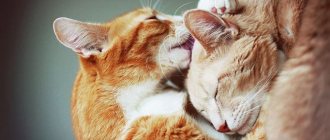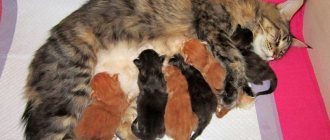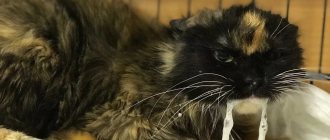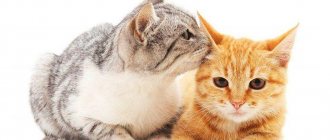It’s unlikely that anyone would argue that most people love cats. Of course, there are also dog lovers. But as statistics show, kittens and children still cause more affection.
Cats decorate our lives, making it warmer and more comfortable. They fill our home with joy and playful games; in difficult moments they can be wonderful interlocutors and listeners. Most often they get along well with children and tolerate all their pranks and jokes on them; can be both a nanny and a teacher. And on cold, cloudy and sad days, curled up on our laps, they serve us as an excellent cure for any blues.
But what can you do when suddenly something goes wrong with this sweet positivity?
What's wrong with the cat?
A loving owner, of course, knows perfectly well all the habits and manners of his pet. And he will easily notice any deviation from the norm. But we must not forget that as an animal grows up, it becomes calmer, and its life becomes more measured. And just recently, a playful baby, carefree chasing balls and toys on the floor, may begin to spend more time in a bed or on the window and sleep more than play. It is important to correctly assess the situation here. Is this behavior a sign of illness or is something bothering the pet, or is it just growing up and a certain stage in the cat’s life.
Maybe the cat is sick?
There are usually several dangerous symptoms indicating an unhealthy state of a pet. And if you notice something suspicious about your pet, then analyze its condition as a whole.
Signs that a cat is sick:
- The animal became inactive. The pet does not react to toys, food, and even irritants that previously caused a strong reaction in him (for example, a vacuum cleaner). Spends most of his time sleeping.
- The animal, on the contrary, can become very active. For example, if your cat follows you and constantly meows for no reason, he may be trying to show you that something is bothering him.
- Refuses food completely or partially. Loss of appetite is observed in cats during the hot season. This is due to the fact that many breeds have difficulty withstanding heat. But by autumn, appetite is usually restored. If the loss of appetite is not associated with temperature changes, and is also accompanied by apathy of the pet, then most likely he is sick.
- Painful urination. The pet's urine becomes dark in color and when visiting the litter box, the cat may meow in pain. All of the above symptoms may indicate urolithiasis.
- Watery or purulent discharge from the nose or eyes can be a sign of both allergic reactions and infectious diseases.
- Scratching the ears and the area nearby, neck. In this case, it is worth checking your pet for the presence of ear mites, fleas and other ectoparasites.
- Diarrhea, nausea, vomiting. May be a sign of animal poisoning.
- The animal does not step on its paw. This may be a sign of either a dislocation or sprain, or external damage (cut, abrasion).
- Hair loss and the formation of bald patches are often a sign of ringworm. The disease is contagious.
- Bloating in general or enlargement/bulging of a particular area. More often it is a sign of liver disease or other internal organs.
- Presence of blood, pus, and mucus in feces.
- Increased body temperature.
- Loss of body weight.
- Putrid odor from the mouth or ear.
Dental diseases
The most common dental pathologies in cats include:
- periodontal disease is a non-inflammatory disease characterized by the occurrence of degenerative processes in the tissues surrounding the tooth, exposure of the tooth root and increased mobility;
- Tartar deposits;
- resorptive dental disease - a disease manifested by the appearance of pockets of cavities in the tooth structure;
- juvenile gingivitis - inflammation of the gums that occurs during the process of changing teeth and is protracted;
- dental injuries: fractures, enamel chips, thermal burns.
Most often, an animal owner may suspect oral diseases by the appearance of bad breath, increased salivation, and bleeding gums.
Treatment of the animal is prescribed by a veterinary dentist after a thorough examination of the oral cavity (most often under anesthesia). Often, therapeutic and diagnostic procedures involve radiography and ultrasonic teeth cleaning.
To prevent oral pathologies, regular brushing of teeth with specialized toothpaste, as well as the use of professional foods that help remove plaque, are recommended. Cats predisposed to plaque formation are recommended to use specialized diets from Purina® PRO PLAN® Dental Plus®. Their unique formula helps prevent the appearance of tartar and reduce plaque formation by up to 40%.
How to help a cat?
Since most owners do not have veterinary or medical education and cannot fully determine the diagnosis with accuracy. And you don’t need to do this yourself in this case, since a mistake and untimely assistance can lead to irreversible consequences. The best solution would be to show your pet to specialists and go to a veterinary clinic. Where the pet will undergo a full examination and receive an accurate diagnosis. Since in a number of diseases, in addition to studying the symptoms, it is also necessary to check blood tests, urine tests and other observations and studies.
Is pneumonia contagious?
The inflammatory process in the pulmonary system most often appears due to the multiplication of the virus and as a complication of influenza or acute respiratory viral infection. In such cases, it is impossible to get sick from pneumonia itself, but it is easy to catch the disease that became the root cause. That is, pneumonia itself is not contagious, and the development of inflammation in the lungs is an independent complication that arose against the background of a weakened immune system and improper self-medication.
Can pneumonia go away on its own without treatment?
Pneumonia or pneumonia is one of the most dangerous and common diseases of the respiratory system. The danger is that specialists do not always have time to make a diagnosis in time. People do not go to the doctor with a cough and fever, but prefer to stay at home for a couple of days until the disease spreads. The condition can worsen to bilateral pneumonia, which carries severe consequences, long-term treatment or chronic diseases.
A hundred years ago, before the discovery of penicillin, pneumonia took the lives of those who fell ill. Science and medicine do not stand still - our lives have changed dramatically in a hundred years. People have antibiotics in every medicine cabinet, and hospitals carry out operations using modern equipment. However, according to the Russian Academy of Sciences, pneumonia is still on the list of the deadliest infectious diseases and should not be underestimated.
Pneumonia will not go away on its own. This disease can lead to death, so seeing a doctor is vital. Treatment for pneumonia should be prescribed by a doctor. It is he who determines whether antibiotics are needed and which ones, and also decides on the severity of the disease.
With pneumonia there is always a high temperature and a strong cough, is this true?
This is a very big and dangerous misconception. Errors in diagnosing the disease are one of the main causes of mortality from pneumonia. According to doctors, up to 30% of cases of pneumonia are not diagnosed or detected too late, since people do not see the need to see a doctor before a high temperature appears. As a result, this leads to a deterioration in the person’s condition and the development of severe complications. Asymptomatic, hidden, but real pneumonia often develops in children and the elderly. The main and most dangerous problem in diagnosing pneumonia in elderly patients is that the disease successfully disguises itself as various chronic diseases. In this case, it passes without the most important marker of the disease for us - without fever. How then do you understand that pneumonia is going away in an adult? - Monitor your body, and promptly consult a doctor if your health worsens.
If you have what signs you should consult a doctor?
- increased sweating;
- weakness;
- dyspnea.
By the way, the myth that pneumonia is necessarily accompanied by a severe cough is just a myth. This problem is mostly characteristic not of the older generation, but of children. There are often cases when pneumonia progresses, but there is no cough. If you do not consult a doctor in time and do not make a diagnosis, the child may experience chronic consequences.
Pneumonia in children can be identified by the following symptoms:
- shortness of breath and chest pain when moving;
- pain when turning the body
- inability to take a deep breath;
- tachycardia;
- exercise intolerance;
- fast fatiguability;
- weakness;
- the person looks pale, but with a bright, unhealthy blush.
How is pneumonia transmitted?
The disease can be transmitted in different ways, including:
- Airborne method. During the disease, droplets form on the mucous membrane of the mouth and nose, which spread through the air during sneezing and coughing. You can become infected by airborne droplets in any public place: hospital, store, public transport. The pathogenic agent spreads through the air along with particles of mucus, sputum, and saliva.
- Contact. The infection is also transmitted through contact - shaking hands, hugging, kissing. People become infected when they touch contaminated objects or when they touch their mouth, eyes, or nose with dirty hands.
- Domestic. The infection can be transmitted through shared towels, dishes and bedding. Therefore, the patient needs to be provided with personal hygiene items, and, if possible, change and wash them more often.
- Fecal. The virus survives up to two days in fecal matter with normal bowel movements. You can easily acquire the disease from improper toilet cleaning or personal hygiene. To prevent infection, especially from young children, it is important to constantly wash your hands after cleaning the child's potty, change diapers frequently and thoroughly wash the area where bowel movements occur.
However, personal hygiene items must be handled very carefully. It has been proven that the viral microorganism can survive up to 4 hours on any surface. Morbid bacteria are not afraid of frost; even with bleach it can be destroyed only five minutes after direct treatment.
In what cases can the owner provide assistance himself?
For example, a kitten cut its paw on a sharp object. Minor abrasion. And is it really necessary to take him to the doctor? Well, of course, the owner can handle this on his own. It is enough to wash the cut with a 3% hydrogen peroxide solution and then treat it with a chlorhexidine solution. But at the same time, you also need to evaluate whether the cut is deep and observe whether the bleeding has stopped. If the cut is deep and the bleeding does not stop for a long time, then it is still worth showing your pet to a specialist.
What if the owner discovered ringworm on his pet? He can handle this on his own too. Purchase ointment from a veterinary pharmacy and treat the affected area with it. It is important to maintain hygiene for the animal and all family members, since the disease is contagious.
Allergic and infectious diseases of the eyes and nose, and damage to the ears by ear mites can also be treated by purchasing the appropriate drops and ointments from a veterinary pharmacy. But you need to monitor the condition of the cat. If there is no improvement within 3-4 days, then still consult a specialist.
If there are signs of poisoning in a pet, an adsorbent (smecta) and drinking in large quantities is necessary. If the pet refuses water, forced drinking through a syringe is used. And again, if there is no improvement in the condition, a doctor’s examination is required.
Condition of coat and skin
A healthy cat has elastic, smooth skin (without foreign formations, swelling and wounds), toned muscles, smooth, shiny, not disheveled fur (the hairs adhere well to each other), without bald patches and dandruff, without ectoparasites and traces of their vital activity.
If the skin of an adult cat or kitten does not meet these requirements, then there is a high probability of developing pathology. Very often, skin changes (local lesions or systemic damage) are a sign of some deeper and more serious disease.
In this case, consultation with a veterinarian is required to make a correct diagnosis and further treatment.
First aid kit for cats
If you have a cat at home, it is better to prepare a first aid kit in advance for unforeseen situations. A first aid kit may include the following:
- Hydrogen peroxide solution 3%;
- Chlorhexidine bigluconate solution;
- Antihistamine;
- Antibiotic eye drops;
- An anthelmintic, such as Milbemax;
- Smecta;
- Bandage;
- Cotton wool;
- Bactericidal patch.
Adviсe
To avoid many health problems in your cat, it is advisable to follow some rules:
- Balanced cat nutrition;
- Give vitamin complexes regularly (2 times a year);
- Regular vaccination and deworming;
- Avoid contact with sick animals;
- Walks in the open air,
- Hygiene of ears, eyes and fur.
Behavior
Behavior in cats can vary depending on the type of disease, but it is always the earliest symptom of any feline disease. Whatever the normal behavior, in a sick cat it will always be different from usual.
For example, with elevated temperature, intoxication, or internal bleeding, the cat will be lethargic, indifferent, and will try to distance itself from any contact. And with carnivore rabies, which affects the nervous system, the cat is likely to be agitated, even aggressive, then overly affectionate, and later paralyzed.
Important! If there are obvious injuries, the cat will try to leave to avoid inspection and any manipulation. It is especially important to remember this if hidden injuries are suspected.











